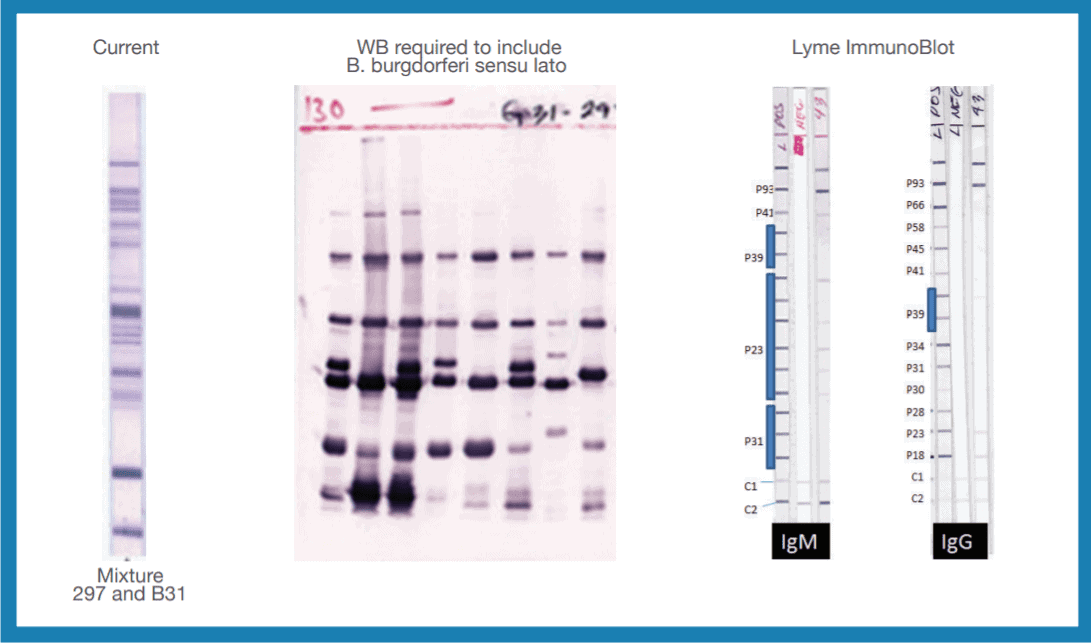Traditional antibody testing for tick-borne diseases like Lyme, Tick-Borne Relapsing Fever, and Bartonellosis is notoriously limited and prone to false negatives. In this article, learn about why the ImmunoBlot is a much more sensitive and accurate test for both tick-borne diseases and COVID-19.
What is an ImmunoBlot?
The ImmunoBlot is the most advanced antibody test available for certain tick-borne diseases as well as COVID-19. It is a multi-species test that is more accurate and sensitive than the traditionally recommended tests – namely the ELISA, Western blot, and IFA.
How the ImmunoBlot works
Recombinant Proteins
The ImmunoBlot uses multiple pure, recombinant proteins rather than proteins from cell cultures. An advantage of using recombinant proteins rather than proteins from natural sources is that recombinant technology allows for the creation of DNA sequences that would not naturally exist under normal circumstances and environmental conditions, which increases the specificity and sensitivity of the test.
Placement on the Blot
In an ImmunoBlot, the recombinant proteins are sprayed at specific positions on a blot, as seen in the image below showing a comparison of the Lyme ImmunoBlot vs. Western blot. This is in contrast to the Western blot, in which proteins are separated only by size. In the Western blot, more than one protein can be present in the same location, including non-specific antigens that may or may not represent Borrelia infection, ultimately reducing specificity and accuracy.

Advantages of the ImmunoBlot
One of the major advantages of the ImmunoBlot is that it can detect antibodies to more species and strains of bacteria than traditional tests. For example, the Western blot for Lyme is typically made with only one species of Borrelia burgdorferi, usually B31. At IGeneX the Western Blots are made with two strains of Borrelia burgdorferi – 297 and B31 – as seen in the strip to the left in the image above. The Lyme ImmunoBlot, on the other hand, includes all Borrelia-specific antigens relevant in North America and Europe.
Sometimes a Western blot is also referred to as an immunoblot by a lab. Remember – not all blots are created equal.

What diseases can be detected with an ImmunoBlot?
IGeneX has developed ImmunoBlots for the following tick-borne diseases:
- Lyme disease: The Lyme ImmunoBlot detects more species and strains of Lyme than any other test, not just 297 and B31.
- Tick-Borne Relapsing Fever (TBRF): The TBRF ImmunoBlot detects antibodies to species of TBRF-causing bacteria relevant in North America, Australia, and Europe – the most common North American species being miyamotoi, B. hermsii, and B. turicatae.
- Bartonellosis (Cat Scratch Disease): The Bartonellosis ImmunoBlot is able to detect more species (including henselae, B. quintana, B. elizabethae, and B. vinsonii) and strains (at least 15) of Bartonella than other tests, making it much more accurate and sensitive than traditional tests such as the IFA and Western blot.
The ImmunoBlot is also available for COVID-19. As with the tick-borne diseases described above, the COVID-19 ImmunoBlot detects both IgM and IgG antibodies, enabling it to detect infections at multiple stages of infection. It can also detect more antigen types, containing four antigen bands compared to the single antigen detected by most other tests.
To learn more about how the ImmunoBlot works for each disease listed, check out the IGeneX ImmunoBlot fact sheet.
ImmunoBlot vs. Western blot and other tests: Recap
The ImmunoBlot is more accurate and sensitive than the CDC-recommended tick-borne disease tests. Again, the ImmunoBlot’s advantages lie partly in its use of recombinant DNA technology and partly in the fact that it can detect more species of disease-causing bacteria. Below is a summary of the advantages of the ImmunoBlot vs. Western blot, ELISA, and IFA for tick-borne diseases.
- Tests for multiple species and strains of bacteria, not just one or two
- The Lyme ImmunoBlot detects antibodies to all relevant species and strains of Lyme Borrelia in North America whereas the Western blot and ELISA can typically only detect 297 and B31
- The TBRF ImmunoBlot detects antibodies to all relevant species and strains of TBRF bacteria from North America, Europe, and Australia
- The Bartonella ImmunoBlot detects IgG and IgM antibodies for the most common species of North American Bartonella and at least 15 strains, making it much more accurate than IFA tests
- Uses recombinant proteins rather than proteins from natural sources
- Proteins are sprayed onto specific positions on the strip rather than separated by size, as in the Western blot
- Only one test strip is needed to test for multiple species and strains rather than the multiple strips needed in a Western blot
Together, these advantages make the ImmunoBlot more efficient, simpler to use and read, and most importantly, more specific, sensitive, and accurate than traditional tests.
Testing for tick-borne diseases
The ImmunoBlot is the most advanced antibody testing available for tick-borne diseases, but it’s not the only test. In some cases, such as with Bartonellosis, the ImmunoBlot in fact works best as a complement to direct tests such as PCR and FISH. That’s why IGeneX has designed testing panels to give the most accurate diagnostic picture. Learn more about testing for tick-borne diseases with IGeneX.








